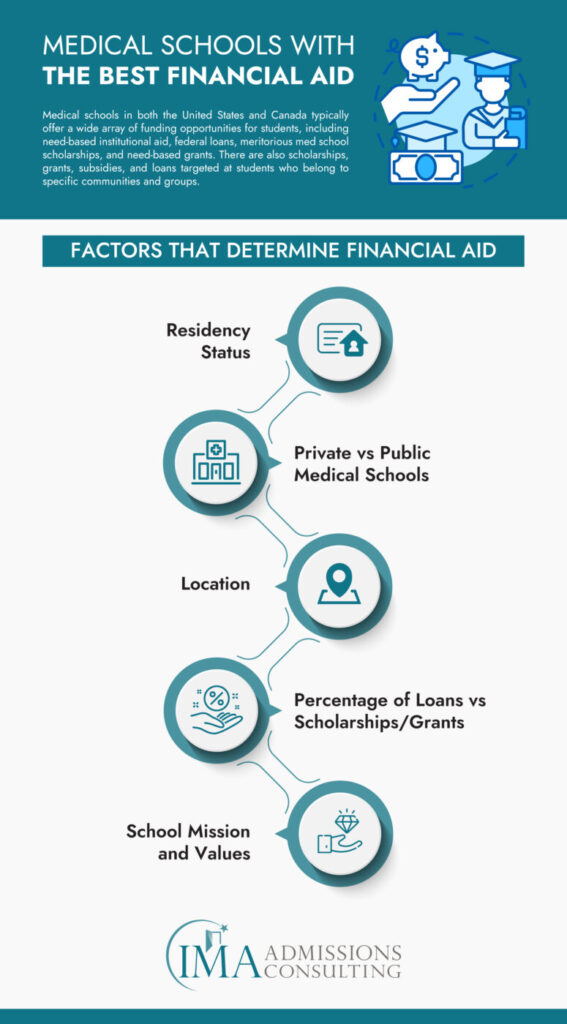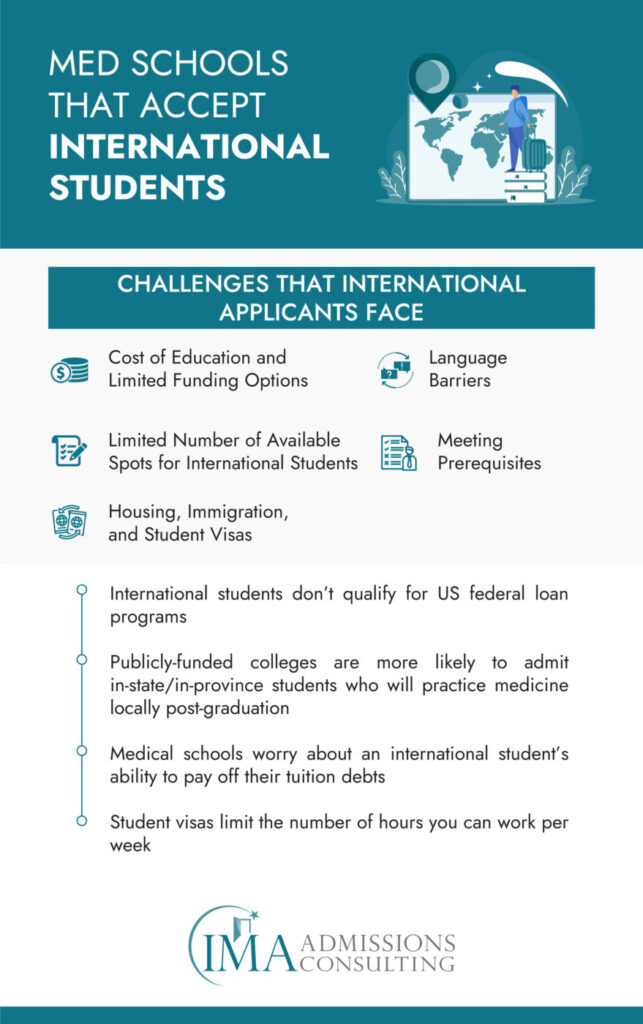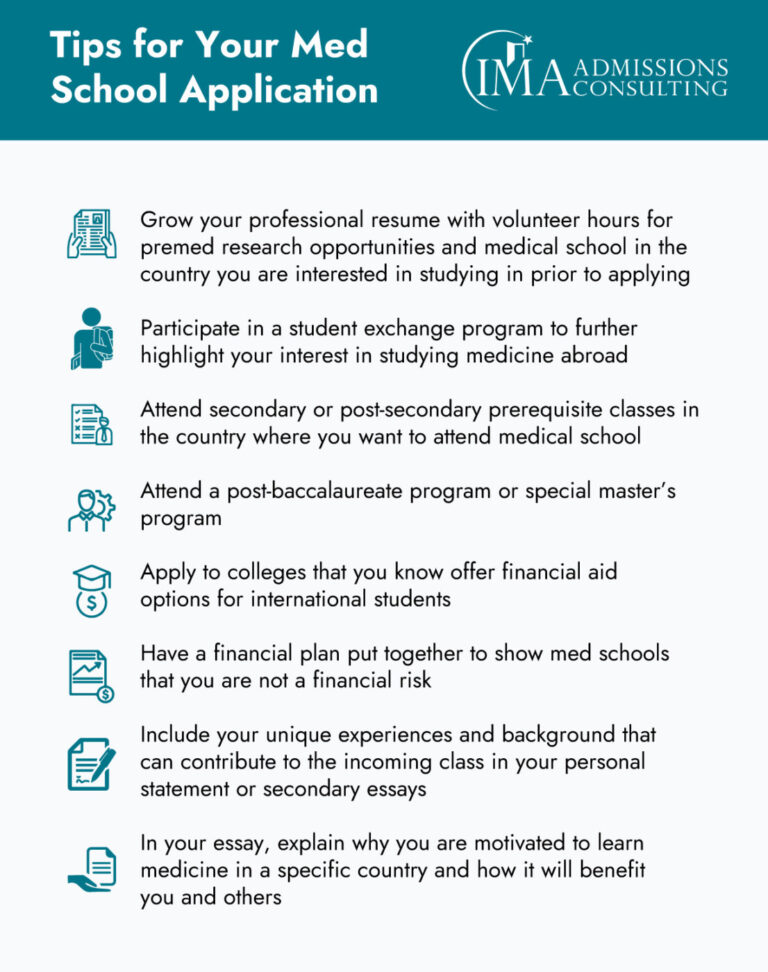Do All Med Schools Accept International Students?
Receiving an education at a medical school abroad is often difficult for international students. No two med schools are alike, but the reasons why a medical school might turn away an international student are similar across the board and frequently boil down to two main issues—location and money.
According to the AAMC (Association of American Medical Colleges), there is a shortage of doctors and this shortage is expected to grow to a staggering statistic of 124,000 missing medical professionals by the year 2034. Despite the current shortage, some medical schools, particularly public med schools, are apprehensive to admit international students. Public institutions are partially government funded, meaning a portion of the funding the college receives comes from the state or province where the school is located. This government funding is meant to subsidize the cost of attendance for in-state/in-province students since these students are more likely to stay within the area to practice medicine. Due to this, medical schools give preference to applicants who are likely to remain within the area after graduating. This, in turn, would help assuage the doctor shortage within the area local to the college.
The other main reason why some medical schools have closed admissions to international students is due to the schools’ concerns regarding whether a student will be able to pay off their med school debt. Most medical schools are costly to attend. The average cost of med school tuition in the United States is approximately $53,200 per year. Due to the high cost of yearly tuition, it is not unusual for students to apply for medical school scholarships, student loans, and bursaries in hopes of covering the financial burden associated with attending med school. Because of the hefty cost that comes with attending college, some universities may choose to refuse admission to international applicants for fear of them being unable to pay off their debts—earning their degree, returning to their home country, and skipping out on paying any remaining debt owed.
Some of the funding available to medical school students in the US and Canada may only be available to local applicants, meaning that international students may be ineligible for financial aid.

Medical Schools with the Best Financial Aid
Medical schools in both the United States and Canada typically offer a wide array of funding opportunities for students, including need-based institutional aid, federal loans, meritorious med school scholarships, and need-based grants. There are also scholarships, grants, subsidies, and loans targeted at students who belong to specific communities and groups.
Factors that Determine Financial Aid
- Residency Status
- Private vs Public Medical Schools
- Location
- Percentage of Loans vs Scholarships/Grants
- School Mission and Values
Some medical schools choose not to accept international students due to potential complications related to student and work visas. As part of the medical school application process, international applicants are required to obtain a student visa in order to study medicine in the country of their choice. After they begin their residency, the same international students will then need to apply for a work visa if they are not permanent residents or citizens of the country where they are attending college. If any complications or delays arise during the visa application process, an international medical school graduate can be barred from participating in residency. To prevent any complications that could arise during the visa application process, some med schools choose to refuse international students.
Challenges to Anticipate When Applying as an International Student
Some of the more common challenges faced by international applicants hoping to attend med school abroad are the cost of education, limited funding opportunities, limited spots available, meeting prerequisites, and language barriers.
One concern for students abroad who are looking to attend med school in the United States or Canada is the language barrier. Studying in another language is difficult enough, let alone trying to incorporate complicated medical terminology and procedures into the mix. These complicated terms add a new layer of difficulty to an already impressive challenge. For this reason, the majority of med schools in English-speaking countries require students that come from countries where English is not the official language to include their TOEFL (Test of English as a Foreign Language) results as part of their application and may even request that students complete one to two years of college in the US or Canada.
However, a student’s proficiency in the English language isn’t the only language barrier they may face. Med schools require letters of reference/recommendation in addition to official transcripts upon application. For international students, this may mean that they need to have their documents officially translated or accredited. This is an additional expense that will come out of the student’s pocket. Not to mention the tremendous amount of paperwork and red tape that is to be expected with international applications. You must make sure that your documents are legible and accepted by the schools you are applying to, applicants also must concern themselves with documentation related to housing, student visas, and immigration. The many potential complications that may arise from international applications are why students who finish their prerequisites at local schools are favored over international applicants.
As previously mentioned, attending medical school is a costly endeavor with an average price tag of upwards of $50k yearly for tuition. This amount can easily double for international students when taking into account the cost of living expenses, airfare, and additional fees imposed by academic institutions. Funding opportunities for international students are limited because:
- International students do not qualify for US federal loan programs
- Publicly-funded schools are more likely to favor and admit in-state/in-province applicants
- Medical schools worry about how/if a student will have the ability to pay off the tuition debt they accrue
Students who are looking to work part-time to help supplement their income and support their studies need to be mindful of the maximum amount of hours their student visas allow them to work each week. For reference, students who want to study in the US are allowed to work a max of twenty hours per week during a school semester as long as the job is on campus or affiliated with the institution.
The biggest challenge faced by hopeful international students is the limited selection of medical schools that accept international students, plus the lower medical school acceptance rates for international students.
According to the AAMC’s matriculation data for McGill University Faculty of Medicine and Health Sciences, McGill recently had a total of 204 students enrolled in their medical school. Of those enrolled in the program, ten were from out of province and one was an international student (out of a total of 88 international applicants). This correlates to an acceptance rate of one percent. Unfortunately for international students, the acceptance rate of international applicants is similar across the board. Per AAMC’s data, Boston University of Medicine had only two international students register for their medical program out of 628 international students who applied. Johns Hopkins had four out of 367 international applicants join their program, and Yale had seven of 431 international applicants join theirs.
It is crucial to ace every step of the application process due to the highly limited number of spots available to international students. You should also know the best time to start your medical school application and seek the help of medical school admissions consulting if you need further help creating a competitive application. Utilizing one-on-one professional guidance during this process can help improve your chances of acceptance and bring you closer to fulfilling your dream of studying medicine abroad. At International Medical Aid, we believe that students can never be too prepared for success. Because of this, we offer a variety of services and resources to help prepare you for medical school, including medical school admission consulting and pre-med shadowing study abroad programs. Our goal is to bridge the gap between a student’s dream and the student’s success and help them get into the medical school of their dreams.
Challenges that International Applicants Face
- Cost of Education and Limited Funding Options
- Language Barriers
- Meeting Prerequisites
- Limited Number of Available Spots for International Students
- Housing, Immigration, and Student Visas
- International students don’t qualify for US federal loan programs
- Publicly-funded colleges are more likely to admit in-state/in-province students who will practice medicine locally post-graduation
- Medical schools worry about an international student’s ability to pay off their tuition debts
- Student visas limit the number of hours you can work per week
The Benefits of Attending Med School as an International Student
The idea of attending medical school as an international student may sound like it’s all doom and gloom, but there are plenty of benefits that come from the experience. One of the biggest and best benefits that comes with attending a medical school in the United States or Canada is the quality of the education you receive. Canada and the US are home to some of the most world-renowned med schools, such as Harvard Medical School, Stanford, Geisel, and the University of Toronto. With such an impressive list of medical schools, it is no wonder that students around the world hope to study abroad.
In addition to the high quality of education, some of the best medical facilities are located in North America. The United States and Canada are home to cutting-edge research facilities and medical facilities like Johns Hopkins Hospital and the Mayo Clinic.
Despite the large price tag that comes with receiving an education in the US or Canada, students who graduate from med school can expect to see a great return on their investment. Physicians are among the most respected and well-earning professionals in both Canada and the United States. Primary care physicians typically earn around $297k per year, and specialists earn around $357k per year.
There are other benefits to attending medical school abroad. While studying in another country, you learn to become self-reliant and hone the skill of self-sufficiency. Nothing teaches you how to trust your instincts and provide for yourself like moving to an unfamiliar city or country. You will also be exposed to new cultures, experiences, and people. Additionally, studying medicine in a second language gives you the chance to practice and grow your conversational language skills.
Studying abroad is also a great way for you to impress future employers. Your studies abroad will showcase your independence and resiliency academically and that you are passionate about medicine and willing to go where ambition takes you. Plus, if you come back from studying abroad having learned a new language, this will make you an even more invaluable asset to any care team you are a part of.

Application Tips for International Students
When applying to a medical school as an international student, standing out from the crowd is essential. Here are some tips to consider:

- Grow your professional resume with volunteer hours for premed research opportunities and medical school in the country you are interested in studying in prior to applying
- Participate in a student exchange program to further highlight your interest in studying medicine abroad
- Attend secondary or post-secondary prerequisite classes in the country where you want to attend medical school
- Attend a post-baccalaureate program or special master’s program
- Apply to colleges that you know offer financial aid options for international students
- Have a financial plan put together to show med schools that you are not a financial risk
- Include your unique experiences and background that can contribute to the incoming class in your personal statement or secondary essays
- In your essay, explain why you are motivated to learn medicine in a specific country and how it will benefit you and others
Applying to medical school as an international student may seem like a daunting experience, but it is manageable with the right plan, mindset, and application. If you plan early, conduct your research and due diligence so you know how to choose a med school that accepts international students, pay attention to the med school application timeline, put your best foot forward, and keep true to yourself and your goals, we are confident you will succeed and nothing can stop you.
List of Med Schools that Accept International Students
While there are plenty of excellent medical schools out there, only the following colleges currently accept international students. We want to remind you that this information and list can change from one application cycle to the next, so always check the colleges’ official websites or the MSAR database for admissions info like what is included below.
| Medical School | Median MCAT | Median GPA | Application Deadline |
|---|---|---|---|
| Boston University College of Medicine | 519 | 3.86 | November 1 |
| Case Western Medical School | 518 | 3.86 | November 1 |
| Columbia Medical School | 521 | 3.93 | October 15 |
| Duke University School of Medicine | 519 | 3.90 | October 15 |
| Emory University School of Medicine | 515 | 3.80 | October 15 |
| Faculty of Medicine Universite Lava | N/A | N/A | November 1 |
| Geisel School of Medicine at Dartmouth | 516 | 3.80 | November 1 |
| Georgetown University School of Medicine | 513 | 3.78 | November 4 |
| Harvard Medical School | 520 | 3.95 | October 15 |
| Howard University College of Medicine | 507 | 3.61 | December 15 |
| Icahn School of Medicine at Mount Sinai | 518 | 3.86 | October 3 |
| Johns Hopkins Medical School | 522 | 3.95 | October 15 |
| McGill University | 512 | 3.89 | November 1 |
| McMaster University | 129(CARS) | 3.87 | N/A |
| Memorial University | 510 | 85% | September 1 |
| Morehouse School of Medicine | 506 | 3.68 | December 1 |
| Northwestern University Feinberg School of Medicine | 520 | 3.92 | November 1 |
| Perelman School of Medicine | 522 | 3.95 | October 15 |
| Queen's University | 511 | 3.81 | October 1 |
| Renaissance School of Medicine | 516 | 3.86 | December 1 |
| Rutgers New Jersey Medical School (NJMS) | 516 | 3.82 | December 1 |
| Saint Louis University School of Medicine | 515 | 3.91 | November 15 |
| Sidney Kimmel Medical College | 514 | 3.82 | November 15 |
| Stanford Medical School | 518 | 3.89 | October 3 |
| State University of New York | 514 | 3.79 | October 15 |
| Burnett School of Medicine at TCU | 510 | 3.67 | November 15 |
| Brown Medical School | 516 | 3.83 | November 1 |
| Tufts University School Of Medicine | 515 | 3.80 | November 1 |
| Tulane University School of Medicine | 510 | 3.65 | October 15 |
| University of Montreal | N/A | N/A | March 1 |
| UC Davis School of Medicine | 511 | 3.63 | October 1 |
| UCLA Medical School | 516 | 3.81 | September 30 |
| University of Chicago Pritzker School of Medicine | 521 | 3.93 | November 15 |
| University of Colorado School of Medicine | 515 | 3.82 | October 15 |
| UConn School of Medicine | 513 | 3.82 | November 15 |
| John A. Burns School of Medicine | 514 | 3.83 | November 1 |
| University of Illinois College of Medicine | 511 | 3.70 | November 1 |
| University of North Carolina Medical School | 515 | 3.80 | October 1 |
| University of Pittsburgh School of Medicine | 517 | 3.86 | October 15 |
| Frederick P. Whiddon College of Medicine | 510 | 3.83 | November 1 |
| University of Toledo College of Medicine | 511 | 3.76 | November 15 |
| University of Toronto Temerty | Minimum Of 125 In Each Section (Except 1 Section With Minimum Of 124) | 3.96 | October 1 |
| University of Utah School of Medicine | 514 | 3.87 | October 1 |
| University of Virginia School of Medicine | 520 | 3.94 | November 1 |
| Université de Sherbrooke | N/A | N/A | November 1 |
| Vanderbilt University School of Medicine | 521 | 3.95 | November 1 |
| Washington University School of Medicine | 521 | 3.93 | November 30 |
| Wayne State School of Medicine | 513 | 3.81 | December 31 |
| Weill Medical College | 520 | 3.93 | October 17 |
| Yale School of Medicine | 521 | 3.93 | October 15 |
Frequently Asked Questions
If the college I want to attend doesn’t accept international students, can I still apply?
We discourage applying to schools that do not accept international applicants as an international student. Applying to a medical school that does not accept international applicants wastes time and money that could be better used to apply to foreign medical schools that do accept international applicants.
Are Canadian students considered international students when applying to medical schools in the United States?
Some medical schools in the United States consider applicants from Canada as out-of-state instead of international medical school applicants. By considering Canadian students as out-of-state applicants, these students have a much higher chance of getting admitted to the US college they applied to. They will also be required to pay the out-of-state tuition rate instead of the international student tuition rate. These schools are typically known as Canadian-friendly US medical schools.
Do I need to attend high school in the same country where I’m applying to medical school?
Yes, sometimes. Although it is not a requirement for all medical schools that accept international students, some require students to complete one to two years of prerequisites in the province or state where their prospective college is located. For the med schools that don’t require students to complete a portion of their schooling abroad, international students are still expected to complete all necessary prerequisites before applying and include their TOEFL results if applicable.
Do I need to get a student and work visa to attend med school as an international student?
To attend medical school abroad, you need to obtain a student visa. Student visas come with specific restrictions, including restrictions on how many hours you are allowed to work while attending school. These visa restrictions can vary depending on the state or province where you are attending college. If you do not become a citizen or permanent resident by the time you have completed your studies, you will need to obtain a valid work visa to complete your residency.
If federal loans aren’t available to international students, does this mean there are no funding opportunities for us?
No, while federal loans are often not accessible to international students, that doesn’t mean that there are no funding options for you. There are plenty of med school scholarships, loan programs, and financial aid options through banks that international students can take advantage of.
As an international student, will I pay more for medical school?
The answer to this question varies from institution to institution. If you attend one of the private medical schools that accept international students, your tuition fees will not be significantly different from the tuition of other students. However, if you attend a public school, your tuition cost will be much higher than that of in-state/in-province students.
If a med school accepts applications from international students, does that mean that someone is always guaranteed a spot?
Unfortunately, no. Although the schools mentioned in our list of medical schools for international students are currently accepting applications from international students, there is no guarantee that any international applicants will be accepted into a college’s med program.
What can I do to improve my chances of being accepted to a medical school as an international student?
As we outlined earlier in the article, there are some ways that you can improve your chances of being admitted into one of the medical schools that accept international students, including:
- Building your resume of work prior to being admitted to med school
- Including your diverse perspective and insight into medicine in your application
- Consulting an advisor at IMA to ensure your application is in the best shape it can be.




